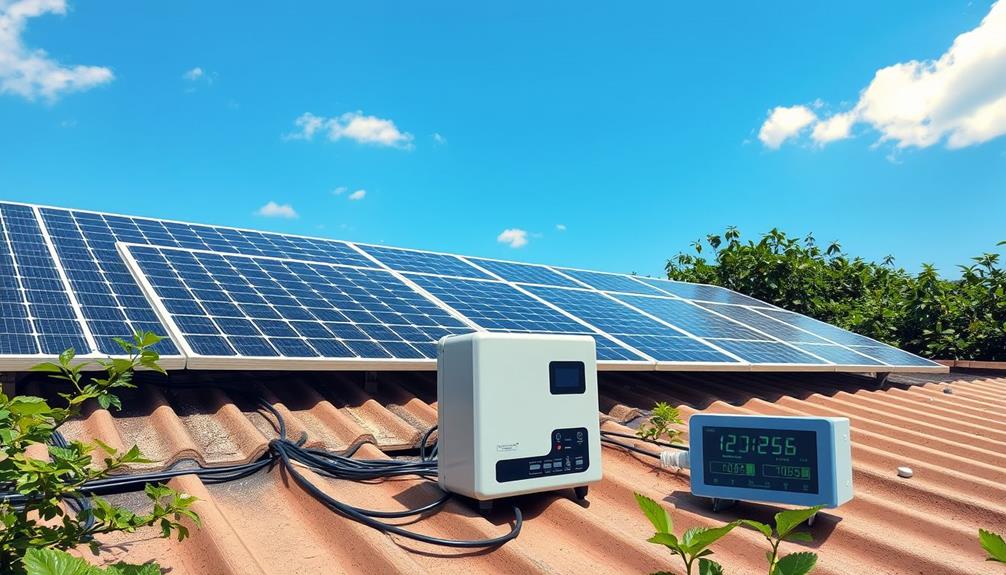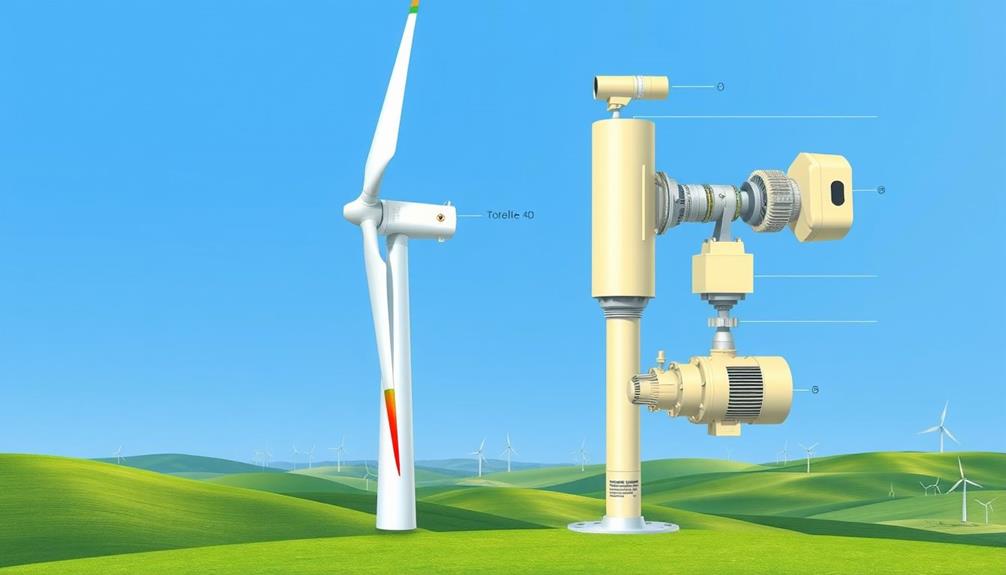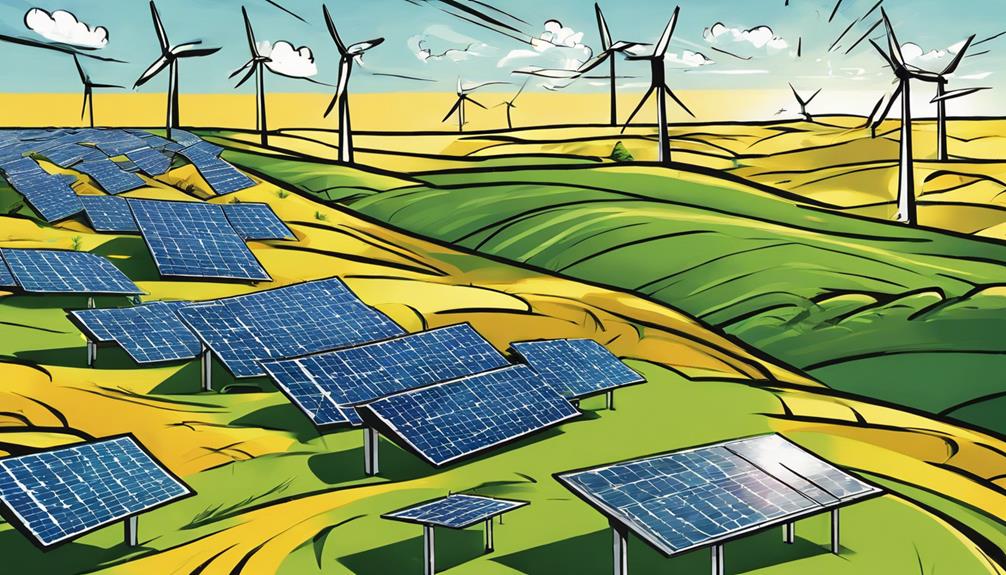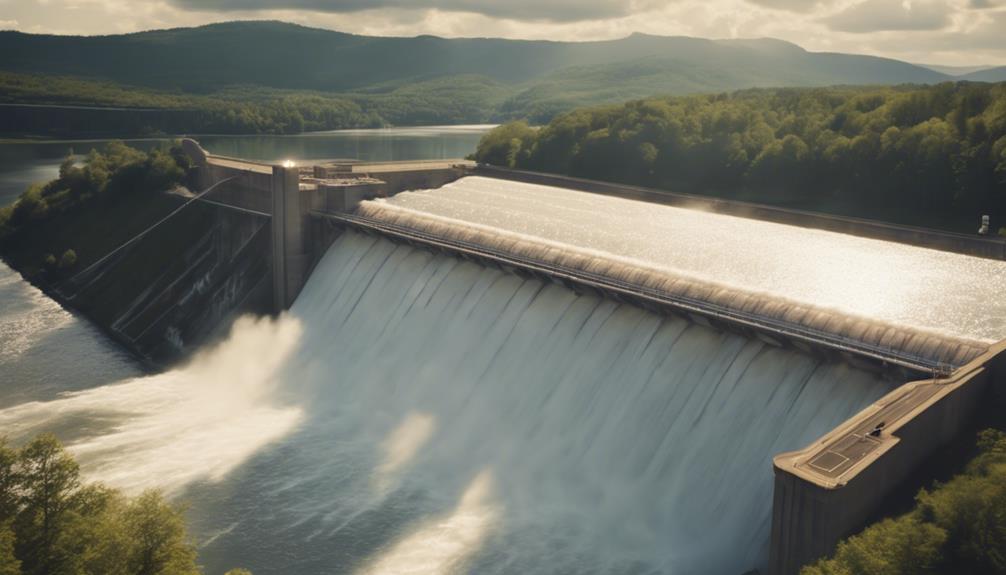Using a step-down converter is essential for managing your solar power like a pro. It efficiently reduces high voltage levels from your solar panels, preventing damage and maximizing system performance. Start by measuring your panel's voltage with a multimeter, ensuring it's disconnected for accuracy. If the voltage is too high, consider switching to a parallel configuration or using a high-quality buck converter. Regularly monitor your system to catch any potential issues early, ensuring everything runs smoothly. Stick around to discover more strategies that will elevate your solar power management game!
Key Takeaways
- Utilize step-down converters to effectively reduce higher DC voltage levels, ensuring compatibility with lower voltage devices in your solar power system.
- Regularly monitor voltage levels to prevent overcharging and damage, maximizing the lifespan of your solar equipment and batteries.
- Implement MPPT charge controllers for optimized voltage and current conversion, enhancing overall system efficiency and performance.
- Choose reliable, high-quality step-down converters to avoid overheating and ensure safe operation within specified voltage tolerances.
- Incorporate dedicated battery-to-battery (B2B) chargers for efficient energy transfer between battery systems, improving performance and compatibility.
Understanding Solar Panel Voltage
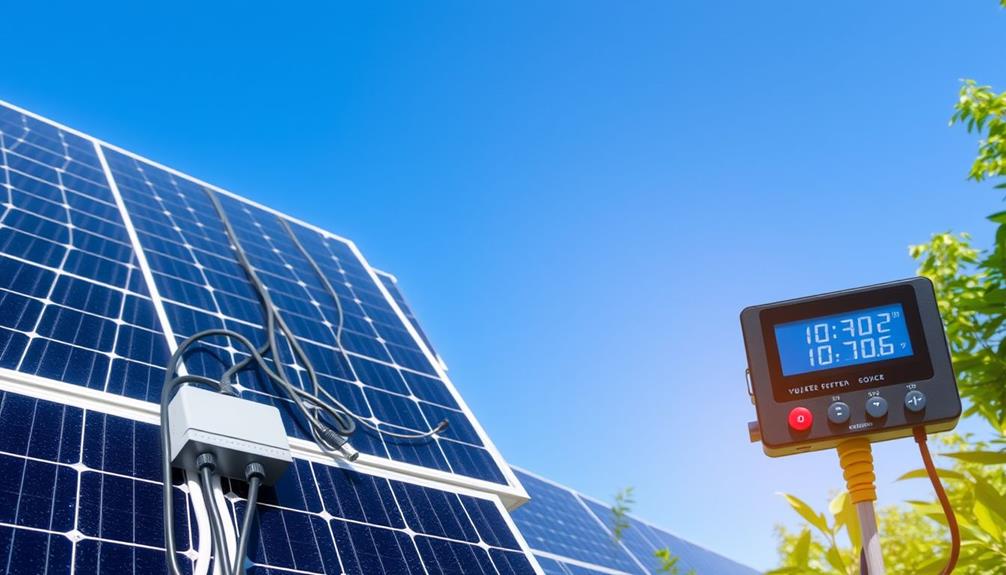
When you're diving into solar power management, understanding solar panel voltage is essential. Solar panel voltage typically ranges from 18 to 30 volts for residential systems, with commercial panels often showing higher voltages. This range emphasizes the importance of voltage management, especially in off-grid setups.
Familiarizing yourself with common financial terms related to investments can also help you make informed decisions about solar investments. The open-circuit voltage (Voc) can reach between 58 to 62 volts, so you need to match this with appropriate charging systems to avoid overvoltage issues.
Using a Maximum Power Point Tracking (MPPT) charge controller is key to optimizing the output voltage and current of your solar panels. These controllers help your system run close to its peak power point, ensuring efficiency.
Remember, the proper operation voltage (Vmp) is usually about 20% lower than Voc, meaning you should monitor these levels closely. Proper voltage management is critical to prevent overcharging your battery, as this can lead to damage and reduce its lifespan.
Make sure your charge controllers and converters are configured correctly to handle the input voltage range of your solar panels. By understanding solar panel voltage, you'll be better equipped to manage your solar power system effectively.
Factors for Voltage Reduction
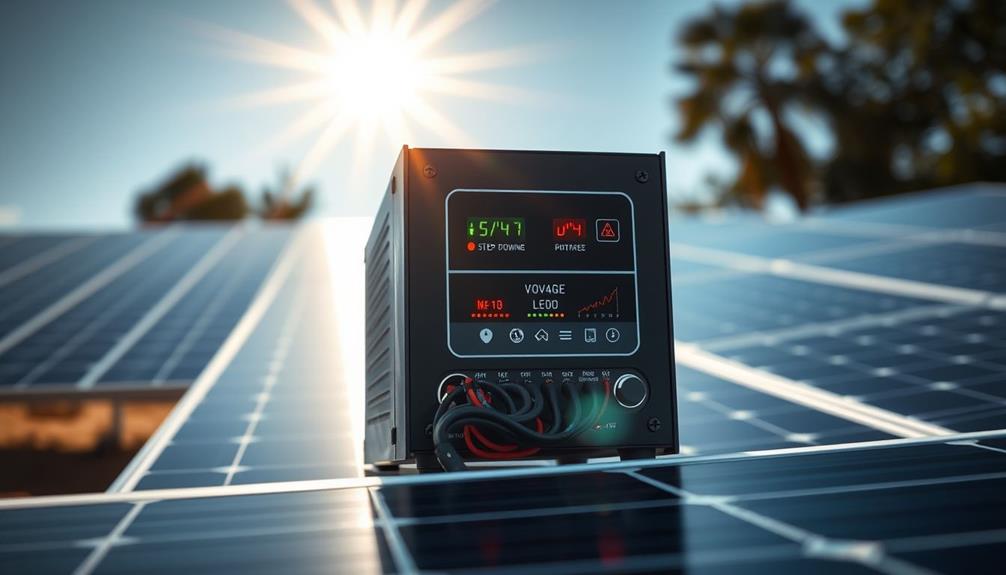
Voltage reduction in solar power systems hinges on several key factors that assure compatibility and efficiency. First, you need to evaluate the voltage, current, and power specifications of your devices. This assessment guarantees that they match the output of your solar system when you implement a step down converter.
Understanding how much voltage reduction is necessary is vital because it directly affects the current and overall performance of your setup. Additionally, utilizing energy-saving features can help maximize the performance of your solar system, similar to the benefits of choosing the best heat pump for ideal energy efficiency.
Next, you should assess the compatibility of your entire solar power system with lower voltage levels. This step can help prevent inefficiencies and protect your equipment from potential damage.
When modifying voltage, always review safety protocols to mitigate risks like electrical shock or fire hazards.
Measuring Solar Panel Voltage
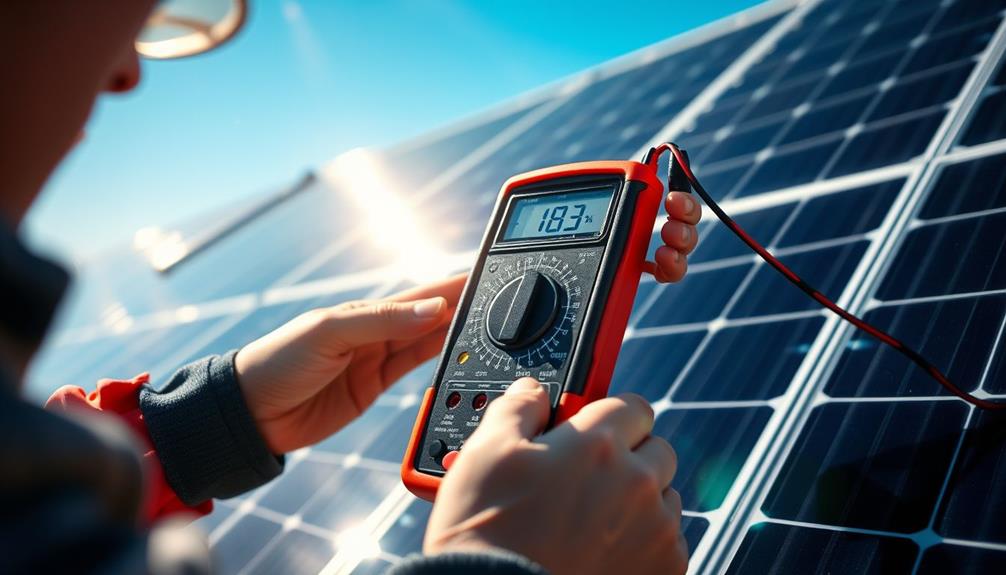
To guarantee your solar panels are functioning effectively, it's important to measure their voltage accurately. Start by using a multimeter set to DC voltage mode. Before testing, make certain the panel is disconnected from any load or battery. This step guarantees you're measuring the open-circuit voltage, which typically ranges from 18 to 30 volts for residential solar panels.
Understanding how variations in solar energy production can influence your system is significant, especially during different seasons, as highlighted in solar energy availability.
Connect the multimeter probes to the solar panel terminals to get the reading. Once you have the voltage, compare it with the panel's label specifications. If the measured voltage exceeds 20% above the rated voltage, it could impair your solar setup's functionality.
Regularly monitoring voltage levels is essential, as excessive voltage can lead to overcharging and potentially damage lead acid batteries and other components linked to your system.
For typical home solar systems, aim to maintain voltage levels between 12 to 48 volts. Keep an eye out for voltages above 15-18 volts in 12V systems, as they pose significant risks.
If you're using a PWM solar charge controller or an MPPT charge controller, proper voltage management is important for efficient energy conversion and safety.
Methods to Reduce Voltage
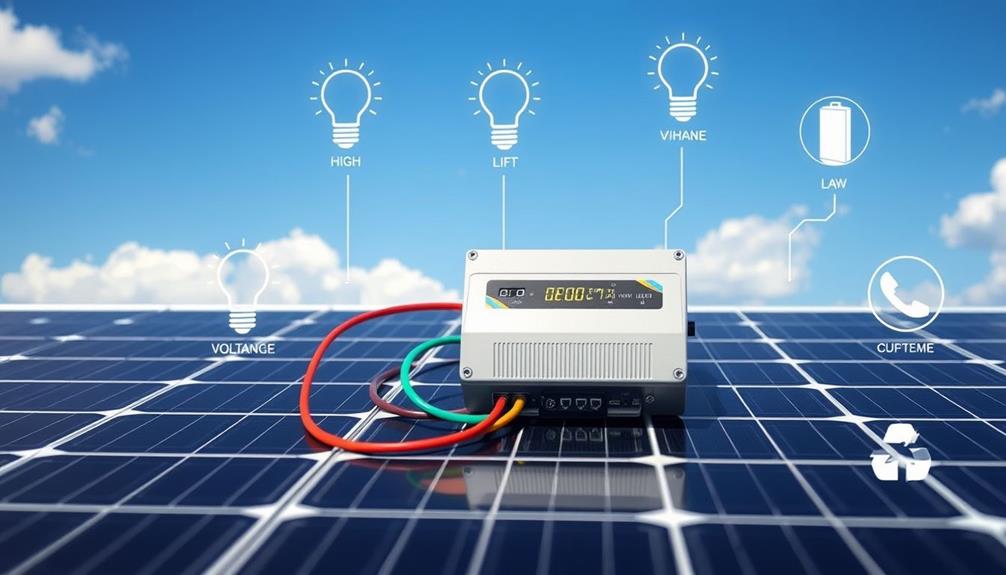
Reducing excess voltage in your solar power system is critical for maintaining efficiency and protecting your components. You can utilize several methods to achieve this. Switching from a series to a parallel wiring configuration lowers panel voltage while increasing output current. Just remember to power down the system during reconfiguration for safety.
Another effective method is using an MPPT (Maximum Power Point Tracking) charge controller. This device optimizes voltage and current conversion, guaranteeing your solar panels operate at peak efficiency while providing the right voltage to your batteries. Additionally, step-down converters, or buck converters, are excellent for reducing higher DC voltage levels to safer levels suitable for battery charging.
To help you keep track of these methods, here's a handy table:
| Method | Function | Safety Tip |
|---|---|---|
| Parallel Wiring | Lowers panel voltage | Power down before reconfiguring |
| MPPT Controller | Optimizes voltage and current | Regular monitoring recommended |
| Step-Down Converter | Reduces voltage for charging | Verify voltage ratings are met |
| Reconfigure Junction Box | Alters voltage/current outputs | Always power off first |
| Regular Voltage Monitoring | Prevents inefficiencies/damage | Check thresholds regularly |
Importance of Voltage Management
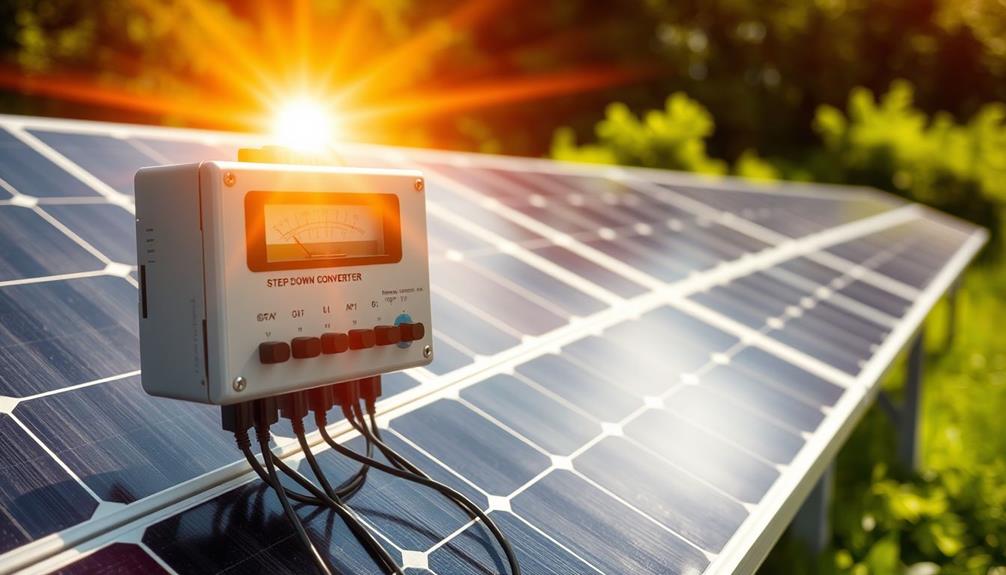
Understanding voltage management is essential for protecting your solar equipment and maximizing its lifespan.
Effective voltage regulation techniques not only enhance performance but can also mirror the transparency found in Gold IRA options, helping you make informed decisions.
By using these techniques, you can guarantee that your system operates smoothly and safely.
This not only enhances performance but also prevents costly damage to your batteries and other components.
Voltage Regulation Techniques
Effective voltage management is important for the longevity and performance of solar power systems. Proper voltage regulation prevents overcharging your batteries, which can lead to serious damage and reduced lifespan.
By using Maximum Power Point Tracking (MPPT) charge controllers, you can enhance both the voltage and current output from your solar panels, guaranteeing efficient energy conversion and enhancing your system's overall performance. Additionally, advancements in technology, such as AI discoveries, are paving the way for innovative solutions in energy management.
Regularly monitoring voltage levels with tools like multimeters is significant. It helps you identify excessive voltage conditions that could cause overheating or even fire hazards if left unchecked.
Implementing step-down converters, or buck converters, allows for safe voltage reductions, but make sure you select and configure them correctly to match your solar panel output and system requirements.
Understanding the specific voltage ranges required for your components is essential. Electrical devices generally operate within narrow voltage tolerances to minimize power losses and guarantee safe functionality.
Impact on Equipment Longevity
Managing voltage levels plays an essential role in extending the lifespan of your solar power equipment. Proper voltage management prevents overvoltage conditions that can cause overheating and damage to components.
By effectively using step-down converters, you can regulate voltage levels, which minimizes the risk of excessive current draw that could degrade battery health over time. Additionally, just as maintaining hygiene is vital for body piercings to prevent infections, piercing care and hygiene emphasizes the importance of regular monitoring to guarantee peak performance.
Regularly monitoring voltage levels allows you to identify potential issues before they escalate, protecting both your solar panels and connected devices from damage.
When combined with an MPPT charge controller that's rated for your system, step-down converters maximize power output while guaranteeing safe voltage levels. This enhances overall system efficiency and equipment longevity.
Equipment Recommendations and Best Practices
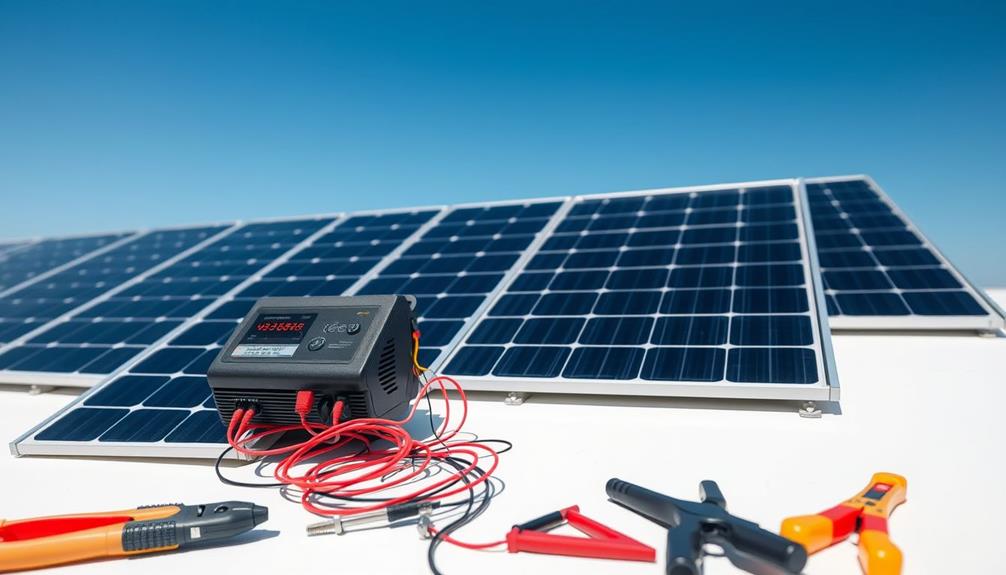
When it comes to optimizing your solar power system, choosing the right equipment is vital for both performance and safety. Start by selecting a reliable step-down converter that meets your expected load and voltage requirements. Inadequately rated converters can overheat and fail, leading to system disruptions. Look for high-quality brands like Victron, as cheaper alternatives often can't handle voltage adjustments effectively.
Additionally, consider the energy efficiency benefits of using reliable appliances to guarantee your overall energy consumption remains low, as highlighted in energy-efficient appliances.
Regularly monitor the output voltage of your step-down converter to guarantee it stays at the required 12V for your devices. This practice prevents potential damage from overvoltage. Also, consider utilizing dedicated battery-to-battery (B2B) chargers in conjunction with your step-down converter. This combination guarantees efficient charging of 12V batteries from a 24V source.
Don't overlook safety measures; using fuses and guaranteeing proper grounding is vital to protect your equipment from electrical faults. Implementing these best practices will enhance the longevity and efficiency of your solar power system while guaranteeing safe operation.
Frequently Asked Questions
How Do I Get the Most Out of My Solar PV System?
To maximize your solar PV system, use an MPPT charge controller, match panel voltage to battery requirements, monitor connections regularly, and account for temperature effects. These steps guarantee efficiency and ideal energy conversion for your needs.
How Do You Optimize Solar to Voltage Conversion?
To optimize solar to voltage conversion, you'll want to balance efficiency with safety. Use an MPPT charge controller, select the right buck converter, and monitor your voltage levels regularly to protect your equipment from damage.
How to Step Down Solar Voltage?
To step down solar voltage, use a DC-DC buck converter or reconfigure your panels to parallel connections. Confirm your equipment's ratings match the output, and regularly monitor voltage levels to prevent overvoltage damage.
How Can I Improve My Solar Inverter Efficiency?
To improve your solar inverter efficiency, use an MPPT charge controller, regularly clean your panels, monitor performance with a multimeter, employ high-quality components, and guarantee your inverter's properly sized for your total connected loads.
Conclusion
In summary, managing your solar power is like conducting an orchestra—every note counts! By understanding solar panel voltage and employing effective voltage reduction methods, you'll harmonize your energy system and maximize efficiency. Remember to regularly measure your voltage and invest in the right equipment to keep everything running smoothly. With these practices, you'll not only enhance your solar setup but also guarantee it performs like a well-tuned symphony for years to come. Additionally, consider incorporating solar lighting for outdoor spaces to further optimize your energy usage and reduce your overall electricity costs. By strategically placing solar-powered lights in your yard or garden, you can harness the power of the sun to illuminate your outdoor area while also benefiting from the cost savings of solar energy. This integrated approach to solar power management will not only enhance the functionality of your outdoor spaces but also contribute to a more sustainable and environmentally friendly lifestyle.
